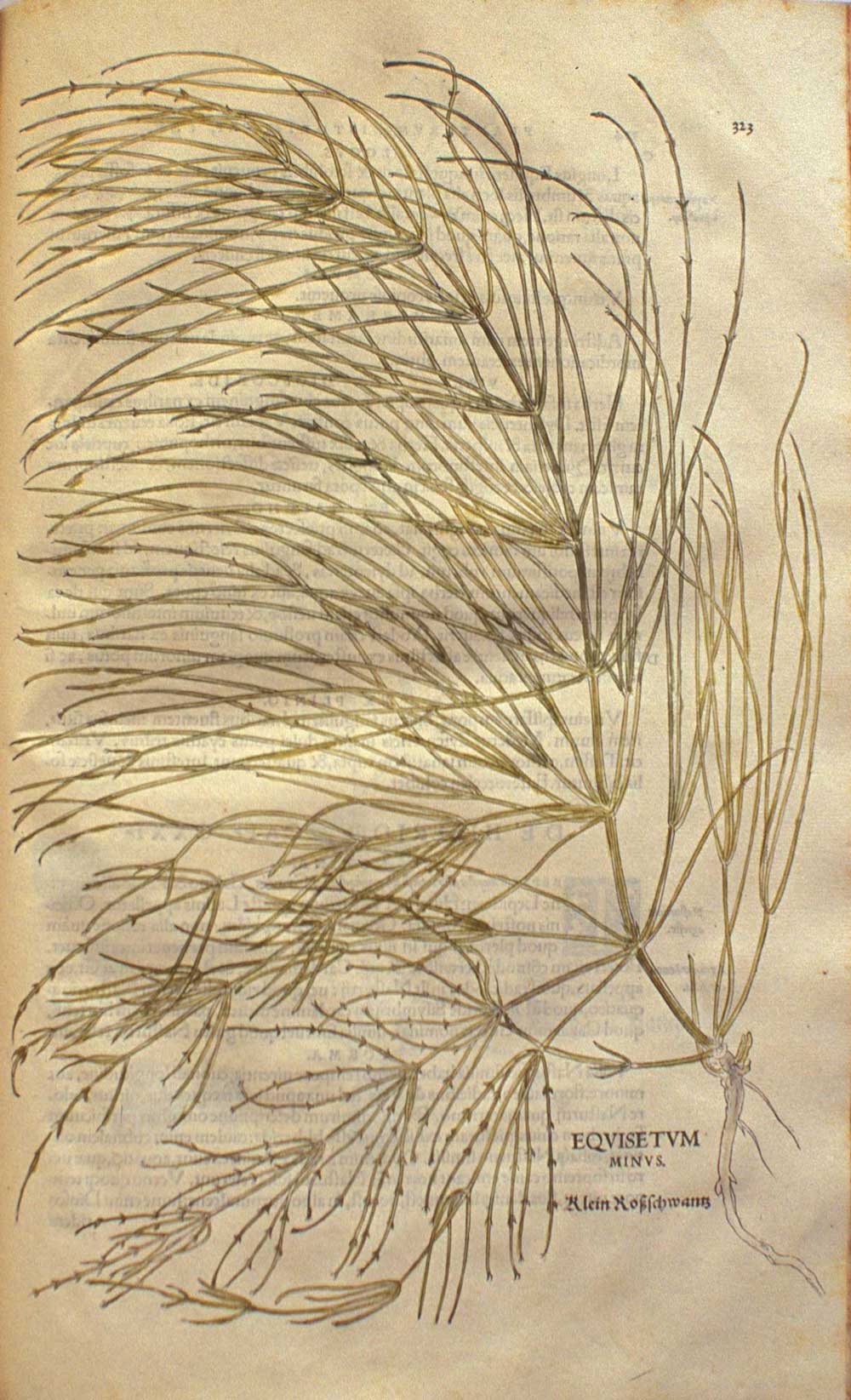than horse-tail to mowers,
Original French: que le Preſle aux Fauſcheurs:
Modern French: que le Presle aux Fauscheurs:
Among the examples of pairings whose antipathies are not as vehement as the hatred thieves have of a certain usage of Pantagruelion.
The section from “La presle aux fauscheurs” (horse-tail to mowers) to “le Lierre aux Murailles” (ivy to walls) was added in the 1552 edition.
Notes
Equisetum

Plate caption: Equistum
minus
Klein Rossschwantz
Taxon: Equisetum arvense L.
English: marsh horsetail
French: prele
German: Zinnkraut
Equisetum

Plate caption: esquisetum alterum
Taxon: Equisetum arvense L.
English: marsh horsetail
French: prele
German: Zinnkraut
La presle… murailles
La presle… murailles. Addition de 1552.
presle
Presle. as Prele.
Prele: Small Horse-taile, Tadpipes, naked Shave-grass.
la presle aux fauscheurs
Prèle, nom vulgaire de diverses espèces du G. Equisetum (Equisétacées). Pline a déjà noté («Equisetum… in pratis vituperata nobis…», XXVI, 83) le discrédit où les tiennent les faucheurs: soit parce que c’est une plante sans valeur et qui gâte le reste du fourrage, soit parce qu’elle émousse le tranchant de la faux. C’est en effet un des végétaux les plus riches en silice: ses cendres en renferment 90%. Ajoutons que les Equisetum palustre et sylvaticum soit toxiques pour les bovidés. (Paul Delaunay)
equisetum
Equisaetum hippuris Graecis dicta et in pratis vituperata nobis—est autem pilus terrae equinae saetae similis—lienes cursorum extinguit decocta fictili novo ad tertias quantum vas capiat et per triduum heminis pota. unctis esculentis ex ante diem unum interdicitur. Graecorum varia circa hanc opinio: alii pinus foliis similem nigricantem eodem nomine appellant, vim eius admirabilem tradentes, sanguinis profluvia vel tacto tantum ea homine sisti, alii hippurin, alii ephedron, alii anabasim vocant, traduntque iuxta arbores nasci et scandentem eas dependere comis iunceis multis nigris ut ex equorum cauda, geniculatis ramulis, folia habere pauca, tenuia, exigua, semen rotundum, simile coriandro, radice lignosa, nasci in arbustis maxime. vis eius spissare corpora. sucus sanguinem e naribus fluentem inclusus sistit, item alvum. medetur dysintericis in vino dulci potus cyathis tribus, urinam ciet, tussim, orthopnoeam sanat, item rupta et quae serpunt. intestinis et vesicae folia bibuntur, enterocelen cohibet. faciunt et aliam hippurim brevioribus et mollioribus comis candidioribusque, perquam utilem ischiadicis et vulneribus ex aceto inpositam propter sistendum sanguinem. et nymphaea trita plagis inponitur. peucedanum cum semine cupressi bibitur, si sanguis per os redditus est fluxitve ab infernis. sideritis tantam vim habet ut quamvis recenti gladiatoris vulneri inligata sanguinem claudat, quod facit et ferulae cinis vel carbo, fungus vero etiam efficacius, qui secundum radicem eius nascitur.
Equisaetum, called hippuris by the Greeks, and found fault with by me when I discussed meadow land [See XVIII § 259] —it is in fact “hair of the earth” resembling horse hair—reduces the spleen of runners if as much as the pot will hold is boiled down to one third in new earthenware, and taken in drink for three days in doses of one hemina. There must be abstinence from fatty foods for at least one day previously. The Greeks hold various views about this plant; some under the same name speak of a dark plant with leaves like those of the pine, assuring us that, so wonderful is its nature, its mere touch stanches a patient’s bleeding; some call it hippuris, others ephedron, others anabasis. Their account is that it grows near trees, which it climbs, and hangs down in many dark, rush-like hairs as if from a horse’s tail; that its little branches are jointed, and its leaves few, slender and small; that the seed is round, resembling that of coriander, that its root is ligneous, and that it grows mostly in plantations. Its property is to brace the body. Its juice, kept in the nostrils, checks haemorrhage therefrom, and it also checks looseness of the bowels. Taken in a sweet wine, in doses of three cyathi, it is good for dysentery, promotes passing of urine, and cures cough and orthopnoea, ruptures also and spreading sores. The leaves are taken in drink for complaints of the bowels and bladder; the plant itself reduces intestinal hernia. The Greeks recognise yet another hippuris, which has shorter, softer and paler hairs, making a very useful application in vinegar for sciatica, and also for cuts, as it stanches the flow of blood. Nymphaea also beaten up is applied to wounds from blows, and peucedanum with cypress seed is taken in drink if blood is brought up through the mouth or flows from the lower passages. Sideritis has such a powerful effect that if bandaged to a gladiator’s wound, however recent, it stops the bleeding, as does also the ash or cinders of fennel-giant, though more efficacious still is the fungus that grows about its root.
equisetum
herba optima in prato trifolii, proxima graminis, pessima nummuli siliquam etiam diram ferentis; invisa et equisaeti est, a similitudine equinae saetae.
The best crop in meadow land is trefoil, the next best grass; money-wort is the worst, and it also bears a terrible pod; horse-hair [The plant now called ‘horse-tail’], named from its resemblance to horses’ hair, is also a hateful weed.
than shavegrass to haymowers
who consider it worthless, and who find that its silicates dull their blades…
La prèle
La prèle (equisetum) est, toujours selon Pline, vitupérée (XXVI, 83) et détestée (XVIII, 67)
La prèle
La prêle nuit à la qualité du fourrage et émousse la faux (Pline, XVIII et XXVI).
Presle
Plante qui émousserait le tranchant de la faux; ce passage, addition de 1552 (var. d) est emprunté à Pline, XVIII, xliv.
prêle
prêle ou prèle: Plante vasculaire sans fleurs (ptéridophyte) rhizomateuse, des lieux humides, qui a des tiges stériles à rameaux verticillés et des tiges fertiles terminées par un épi sporifère. (Les spores de prêle sont remarquables par leurs 4 rubans hygroscopiques, qui assurent leur déplacement au sol ; les tiges, imprégnées de silice, peuvent servir à polir le bois.)